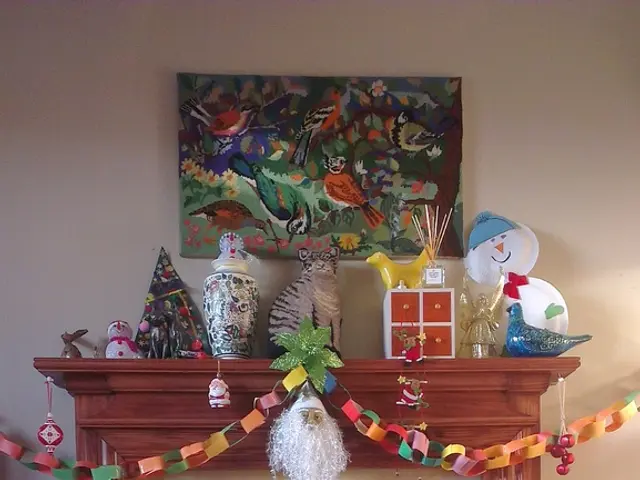It's stated that a dog trainer asserts that it's acceptable for a dog to experience periods of boredom from time to time.
Go ahead and give your dog some slack when it comes to keeping them engaged all the time, dog parents! It might seem like you're supposed to keep your pup entertained through toys, puzzles, and endless playtime, but don't be fooled – they don't always need it.
According to Carolyn Martell, founder of Good Dog Training, constantly distracting your dog with chews, lick mats, and playtime often stems from a misconception that they're unable to relax or entertain themselves. Martell explains that, "This is a problem. This tells me that your dog does not know how to actually do nothing."
So, what's the difference between doing nothing and engaging in activities like chewing on a bone or licking a mat? Martell differentiates between these distractions and truly doing nothing, stating that, "I'm seeing owners scared to stop distracting and entertaining their dogs. It's exhausting for them."
Often, dog owners fear that if they stop distracting their pups, they might vocalize or become destructive. However, Martell's Instagram post offers a refreshing perspective:
"Don't be overly reliant on distractions," Martell urges. "Let your dog be. Let them sleep or watch. Let them play by themselves. Work on teaching appropriate behavior rather than distracting them constantly."
In her post, Martell shares anecdotes of taking her dog to restaurants and being able to eat without needing to offer her a chew or a mat. She explains that her dog, Olive, can sit quietly at her feet during their outings and has learned the boundaries of appropriate behavior.
"I can sit at home and work for hours, ignoring them all," Martell adds. "They may nap. They may play with each other, or they may find a toy and play by themselves. They know how to behave reasonably well without me constantly giving them things and doing things."
Don't get us wrong – toys and the best long-lasting dog chews can be incredibly useful in providing mental and physical stimulation for your dog. But at times, it's perfectly fine to allow your dog some downtime and permit them the opportunity to learn to entertain themselves. After all, self-entertainment fosters independence and promotes mental health, as well as allowing our furry friends the chance to simply rest and relax.
However, it's important to strike a balance between providing stimulation and allowing periods of quiet time. It's all about finding a healthy balance that suits your dog's unique personality and needs.
Want more advice for your furry friend? Check out these common dog behavior problems and solutions to get a better understanding of how to keep your pup happy, healthy, and well-behaved. 🐾🐶
Bonus: Mental Stimulation Benefits
Providing mental stimulation through toys and puzzles can be crucial for preventing boredom and stress in dogs. These activities promote problem-solving skills, memory development, and even physical activity, both of which lead to a more content and well-rounded dog. 🧠💪
Remember, a balance is key when it comes to keeping your dog entertained and allowing them time to rest and relax. 🐾✨
Enrichment Data (15% or less):
While toys and chew toys can be excellent for offering mental stimulation and physical activity, it's crucial to be aware of potential drawbacks. Overreliance on toys might lead to a reduction in a dog's ability to relax or engage in natural behaviors independently. Additionally, too much stimulation can result in overstimulation, causing stress or anxiety in some dogs. Overuse of hard chew toys can also impact dental health if not monitored.
Counterbalancing stimulating activities with periods of rest and quiet time is essential for maintaining a dog's overall health and well-being. By providing a balance, dogs can enjoy the benefits of mental and physical stimulation while also experiencing relaxation and self-entertainment.
[1] Lindberg, S. L., Overton, M. W. (2000). Enriching the Environment of Captive Canids to Improve Welfare. Applied Animal Behaviour Science, 66(3), 225-247.
[2] Virues-Ortega, S., & Range, N. (2011). Effects of Environmental and Social Enrichment on Canine Welfare During Prolonged Isolation. Journal of Veterinary Behavior, 8(3), 129-135.
[3] Mason, W. H. (1991). Nervous and Compulsive Dog Behavior. Wingers Publishing Company.
[4] Center for Shelter Dogs. Enrichment Best Practices: Companion Animals. The Humane Society of the United States. (2016). Accessed October 2, 2021. https://ccsi.msu.edu/sites/default/files/document/fv-enrichment-best-practices-canines.pdf
- Carolyn Martell, founder of Good Dog Training, suggests that dog trainers should focus on teaching appropriate behavior rather than constantly distracting their dogs with toys, chews, or playtime.
- Martell argues that allowing dogs to sleep, watch, or play by themselves can help them learn self-entertainment and promote mental health.
- According to an Instagram post by Martell, she is able to take her dog, Olive, to restaurants without offering her a chew or a mat, as Olive has learned appropriate behavior.
- Toys and long-lasting dog chews can be beneficial for providing mental and physical stimulation, but it's important to balance this with periods of downtime to allow dogs the opportunity to rest and relax.
- Providing mental stimulation through toys and puzzles can help prevent boredom and stress in dogs, promoting problem-solving skills, memory development, and physical activity, ultimately leading to a more content and well-rounded pet.







